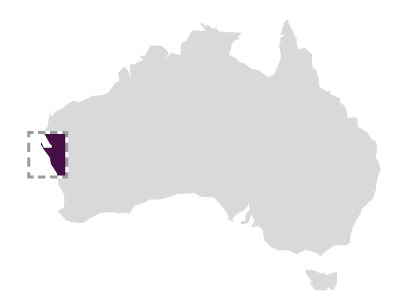Magnolia (12494)
Between Red Bluff and Gnaraloo

After being reported by Peter Fox, in October 1980, a then unidentified wreck c. 9 kilometres south of the Gnaraloo station homestead was inspected by M McCarthy assisted by Colin Powell and Geoff Kimpton. The position, fixed in the pre GPS era was recorded as 23°50’S., 113° 31’E. When he reported finding the wreck Mr Fox delivered to the Museum one glass burner top, a red glass fragment, assorted plank spikes (95mm by 11mm square) and assorted brass bolts 1.25cm in diameter. The inspection team recovered two lead pipe lengths 6cm diameter, a small sounding lead (16cm) and two fishplates.
In the inspection report, the site was described as small, lying in 1-2 metres of water depending on the tide and consisting of iron keel sections, iron ribs, chain, 2 small Admiralty type anchors (one 1.15m by 1.75m) , one with a folding stock, 1 small windlass (1.15m long), a section of another windlass and two sections of lead keel out to sea. The main section of wreckage consisted of two keel sections with brass bolts (60cm by 2.5cm) measuring approximately 15 metres along the main axis.
Of all the known wrecks on the coast, the finds and these scantlings best fitted the circumstances of the fishing boat Magnolia, which according to A.C. Burns who compiled a history of early fishing boats in the region ‘ended her illustrious career when caught in a strong current during the night and went ashore at Red Bluff, north of Cape Cuvier’ on March 17 1938 .
Though Red Bluff is further south, it is the most prominent feature on the relatively featureless coast south of Point Cloates and it is often used to describe the entire region in the vicinity of the Bluff. Further the tentative identification of the wreck as the Magnolia was confirmed by Mr A. Fleming, whose family had owned the Gnaraloo station until a few years prior to the inspection in 1980. Mr Fleming also advised that the wreck had been salvaged by Carnarvon identity ‘Tito’ Reynolds.
When considering this, and the then relatively modern nature of the site the inspection report finished with the advice that ‘the site and does not fit any of the criteria laid down for consideration as an historic wreck’.
According to Burns,
The sea which was not unduly rough, was breaking heavily over the reef, and at the point where the boat went aground was comparatively calm, compared with the areas on either side. The skipper and two crewmen did not leave the boat until she was practically broken up, and getting away in the dinghy they were able to save the sails and some of the gear. After reaching shore they walked to Gnarloo Station the property of r E.K. Roberts, about 7 miles away and acquainted him of the mishap to the boat. Mr Roberts then drove the men in his truck to the scene of the wreck Magnolia, and with the dinghy and gear loaded in the truck were conveyed to Carnarvon, then to Geraldton. At the time of the loss of the Maggie she had in her ice box 800 to 900 lb of Lady Schnapper.
The Magnolia had an interesting history and had been the property of a local firm Winter Brandt and Co. for 30 years. She was 58ft long with a beam of 12’6” and a draft of 10’6”. She was originally built in England and was brought out in sections to Botany Bay, where he was put together. For many years she was a crack sailing yacht in Sydney and Melbourne waters before being acquired for fishing.
In 1989 Mr Bruce Teede of Carnarvon donated fastenings he had recovered from the wreck ‘20-25 years ago’ to the Museum. He also advised that in salvaging the wreck, the Reynolds brothers made a ramp for their Landrover from the shore out to the site and drove out to it at low tide, recovering what they could. Teede to McCarthy, January 1989, 209/80/1) With a 75-year rolling date now accepted as the sole necessary criterion for historic status in recent years, the Magnolia will automatically become historic within in a few years..
References. McCarthy, M., 1980. Assisted by G. Kimpton and C. Powell. Magnolia Wreck inspection Report. Department of Maritime Archaeology WA Museum.
Burns, A.C . Sailing into the Past. A history of Geraldton fishing boats. Private Publication Geraldton
Ship Built
Country Built UK
Ship Lost
Grouped Region Mid-West
Sinking Caught in strong current
When Lost 12494
Where Lost Between Red Bluff and Gnaraloo
Latitude -23.8333333333
Longitude 113.5166666667
Cargo 800 to 900 lb Lady Schnapper
Ship Details
Engine N
Length 17.70
Beam 3.80
Draft 3.10
Museum Reference
Unique Number 923
Sunk Code Wrecked and sunk
File Number 2010/0063/SG _MA-210/80
Protected Protected Federal
Found Y
Inspected Y
Date Inspected 1980/11/11
Confidential NO